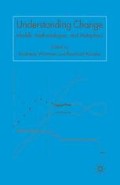Abstract
As Smith & Morowitz (1982) once aptly wrote, biology is a discipline ‘between history and physics’. On one hand, we do have laws in biology, on top of those coming from physics and chemistry. The model system of population genetics is not very different from laws of theoretical physics, except that it contains more variables and parameters. In mechanics we must know the mass of objects, some key forces and the gravitational constant: in population genetics we must know about population size, allele frequencies, linkage, mutation and migration rates, selection coefficients and so on. But this could still be regarded as ‘ordinary’ theoretical science, albeit a bit complicated. On the other hand the laws (or rules, if we are more modest) of population genetics are of the ‘if A, then B’ nature, and often there is nothing within the theory that could decide whether A in fact holds or not. That decision comes from physics, chemistry, or — crucially for our present enquiry — history.
Access this chapter
Tax calculation will be finalised at checkout
Purchases are for personal use only
Preview
Unable to display preview. Download preview PDF.
References
Aunger, R. (2002) The Electric Meme: A New Theory of How We Think. Free Press.
Barrow, John D. & Tippler, Frank J. (1988) The Anthropic Cosmological Principle. Oxford University Press.
Bassanini, A. & Dosi, G. (1999) ‘When and how chance and human will can twist the arms of Clio’. LEM Working Paper Series 1999/05. Pisa.
Benner, S. A. (2002) ‘The past is the key to the present: resurrection of ancient proteins from eosinophils’. Proc. Natl. Acad. Sci. US. 99, 4760–1.
Bickerton, D. (1990) Language and Species. The University of Chicago Press.
Cavalier-Smith, T. (1987) ‘The origin of eukaryotic and archaebacterial cells’. Ann. N. Y. Acad. Sci. 503, 17–54.
Changeux, J.-P. (1983) L’Homme Neuronal. Librairie Arthème Fayard, Paris.
Dawkins, R. (1976) The Selfish Gene. Oxford University Press.
Dawkins, R. (1996) Climbing Mount Improbable. W. W. Norton.
De Duve, C. (2002) Life Evolving: Molecules, Min,. and Meaning. Oxford University Press.
Eigen, M. (1971) ‘Self-organization of matter and the evolution of biological macromolecules’. Naturewissenschaften. 58, 465–523.
Jablonka, E. & Lamb, M. J. (1995) Epigenetic Inheritance and Evolution. Oxford University Press.
Jastrow, R. (1971) Red Giants and White Dwarfs. Harper and Row, New York.
Johnson, P. A., Lenski, R. E. & Hoppensteadt, F. C. (1995) ‘Theoretical analysis of diver gence in mean fitness between genetically identical populations’. Proc. R. Soc. Lond B. 259, 125–30.
Lenski, R. E. & Travisano, M. (1994) ‘Dynamics of adaptation and diversification: a 10,000 generation experiment with bacterial populations’. Proc. Natl. Acad. Sci. USA. 91, 6808–14.
Marshall, C. R., Raff, E. C. & Raff, R. A. (1994) ‘Dollow’s law and the death and resur rection of genes’. Proc. Natl. Acad. Sci. US. 91, 12283–7.
Maynard Smith, J. (1970) ‘Natureal selection and the concept of a protein space’. Nature. 225, 563–4.
Maynard Smith, J. (1982) Evolution and the Theory of Games. Cambridge University Press.
Maynard Smith, J. (1986) The Problems of Biology. Oxford University Press.
Maynard Smith, J. & Szathmáry, E. (1995) The Major Transitions in Evolution. Freeman, Oxford.
Maynard Smith, J. & Szathmáry, E. (1999) The Origins of Life. Oxford University Press.
Orgel, L. E. (1992) Molecular replication. Nature. 358, 203–9.
Pichaud, F., Briscoe, A. & Desplan, C. (1999) ‘Evolution of color vision’. Curr. Op. Neurobiol. 9, 622–7.
Smith, T. F. & Morowitz, H. J. (1982) ‘Between history and physics’… Mol. Evol. 18, 265–82.
Smolin, L. (1999) The Life of the Cosmos. Oxford University Press.
Szathmáry, E. (2000) ‘The evolution of replicators’. Phil. Trans. R. Soc. Lond. B. 355, 1669–76.
Szathmáry, E. (2002a) ‘Units of evolution and units of life’. In: Pályi, G., Zucchi, L. & Caglioti, L. (eds) Fundamentals of Life. pp. 181–95. Elsevier, Paris.
Szathmáry, E. (2002b) ‘Cultural processes: the latest major transition in evolution’. In: Lynn Nadel (ed.), Encyclopedia of Cognitive Science. Macmillan Reference, London.
Szathmáry, E. (2002c) ‘The gospel of inevitability: was the Universe destined to lead to the evolution of humans?’ Nature. 419, 779–80.
Wahl, L. M. & Krakauer, D. C. (2000) ‘Models of experimental evolution: the role of genetic chance and selective necessity’. Genetics. 156, 1437–48.
Wächtershäuser, G. (1988) ‘Before enzymes and templates: theory of surface metabolism’. Microbobiol. Rev. 52, 452–84.
Wächtershäuser, G. (1992) ‘Groundworks for an evolutionary biochemistry: the iron-sulfur world’. Prog. Biophys. Molec. Biol. 58, 85–201.
Yedid, G. & Bell, G. (2002) ‘Macroevolution simulated with autonomously replicating computer programs’. Nature. 420, 810–12.
Zhang, J. & Rosenberg, H. R (2002) ‘Complementary advantageous substitutions in the evolution of an antiviral RNase of higher primates’. Proc. Natl. Acad. Sci. US. 99, 5486–91.
Editor information
Editors and Affiliations
Copyright information
© 2006 Eörs Szathmáry
About this chapter
Cite this chapter
Szathmáry, E. (2006). Path Dependence and Historical Contingency in Biology. In: Wimmer, A., Kössler, R. (eds) Understanding Change. Palgrave Macmillan, London. https://doi.org/10.1057/9780230524644_10
Download citation
DOI: https://doi.org/10.1057/9780230524644_10
Publisher Name: Palgrave Macmillan, London
Print ISBN: 978-1-349-51991-0
Online ISBN: 978-0-230-52464-4
eBook Packages: Palgrave Social & Cultural Studies CollectionSocial Sciences (R0)

